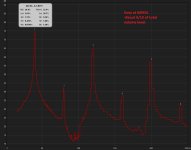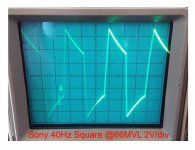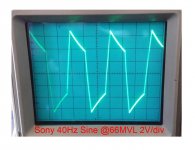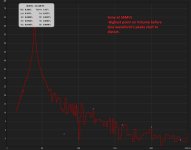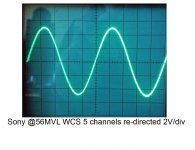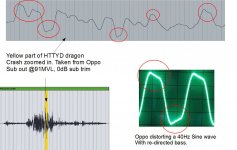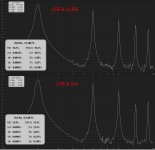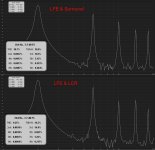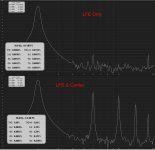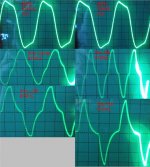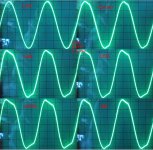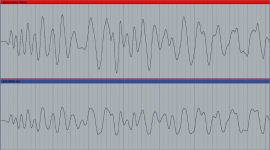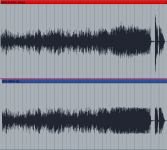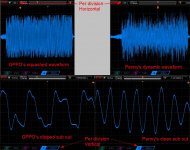First of all, to the Mod's: I know there there is already a thread about this player but what I've found here is huge and I wish somebody had showed me the following data before I wasted over a thousand dollars on this device so I believe it's worth it's own thread...
This is a waveform from the end of the movie Earth to Echo. The waveform with the red border is taken from the analog sub out on a 200 dollar old 1st or 2nd gen Panasonic bluray player. It fades into the green border's waveform which is taken from the sub out of the OPPO BDP-105. Here is a closer view...
What started me on this discovery is my friend maxmercy over at Data-Bass Forums made a disc to test the worst case scenario of re-directed bass in 7 channels added with LFE. Using this disc (a more comprehensive version will be available sometime this summer with many more tests on it) can help find where your preamp's analog sub out starts to clip so you can set your gain stages up accordingly and never push clipped signal to your amp and subs.
What I found is that the 105 can handle a near full reference level (-0.1dB) LFE track at any frequency with the MVL (master volume level) all the way up to 100 without clipping. But as soon as you add even the center channel's re-directed bass with it, it starts clipping and from there the more channels you add of re-directed bass the worse the clipping gets. The WORST part is: it doesn't matter how low you adjust the MVL or the sub trim, the clipping does not go away! It is a problem with how the 105 sums the signals and adds it to the LFE channel so there is no fix for this.
I understand that there isn't going to be many movies with all channels outputting only sine waves in the low frequencies but like I said, this was a worst case test to have a good idea where to set your analog out's (MVL for reference and/or sub trim control) so that a worst case will not take out any amplifiers or drivers in your system. With loudness wars now infiltrating more movie soundtracks full of square waves in multiple channels, we might as well start setting our systems up accordingly.
Look at the following attachments to better understand how the 105 deals with re-directed bass:
An externally hosted image should be here but it was not working when we last tested it.
This is a waveform from the end of the movie Earth to Echo. The waveform with the red border is taken from the analog sub out on a 200 dollar old 1st or 2nd gen Panasonic bluray player. It fades into the green border's waveform which is taken from the sub out of the OPPO BDP-105. Here is a closer view...
An externally hosted image should be here but it was not working when we last tested it.
What started me on this discovery is my friend maxmercy over at Data-Bass Forums made a disc to test the worst case scenario of re-directed bass in 7 channels added with LFE. Using this disc (a more comprehensive version will be available sometime this summer with many more tests on it) can help find where your preamp's analog sub out starts to clip so you can set your gain stages up accordingly and never push clipped signal to your amp and subs.
What I found is that the 105 can handle a near full reference level (-0.1dB) LFE track at any frequency with the MVL (master volume level) all the way up to 100 without clipping. But as soon as you add even the center channel's re-directed bass with it, it starts clipping and from there the more channels you add of re-directed bass the worse the clipping gets. The WORST part is: it doesn't matter how low you adjust the MVL or the sub trim, the clipping does not go away! It is a problem with how the 105 sums the signals and adds it to the LFE channel so there is no fix for this.
I understand that there isn't going to be many movies with all channels outputting only sine waves in the low frequencies but like I said, this was a worst case test to have a good idea where to set your analog out's (MVL for reference and/or sub trim control) so that a worst case will not take out any amplifiers or drivers in your system. With loudness wars now infiltrating more movie soundtracks full of square waves in multiple channels, we might as well start setting our systems up accordingly.
Look at the following attachments to better understand how the 105 deals with re-directed bass:
Attachments
-
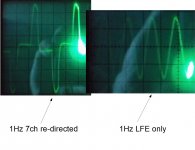 1Hz Scope.jpg71 KB · Views: 222
1Hz Scope.jpg71 KB · Views: 222 -
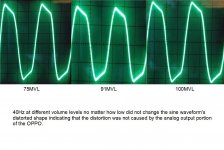 Volume vs distortion.jpg103.3 KB · Views: 100
Volume vs distortion.jpg103.3 KB · Views: 100 -
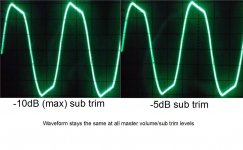 Trim level vs distortion.jpg76.2 KB · Views: 101
Trim level vs distortion.jpg76.2 KB · Views: 101 -
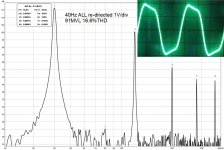 40Hz 7channels.jpg97.5 KB · Views: 110
40Hz 7channels.jpg97.5 KB · Views: 110 -
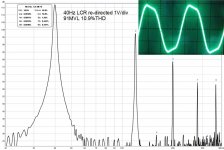 40Hz LCR.jpg94.4 KB · Views: 104
40Hz LCR.jpg94.4 KB · Views: 104 -
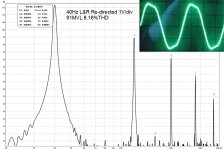 40Hz L&R.jpg90.3 KB · Views: 106
40Hz L&R.jpg90.3 KB · Views: 106 -
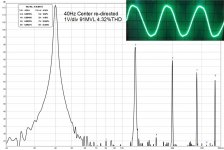 40Hz Center.jpg92.2 KB · Views: 119
40Hz Center.jpg92.2 KB · Views: 119 -
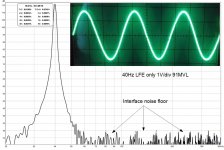 40Hz LFE.jpg103.4 KB · Views: 111
40Hz LFE.jpg103.4 KB · Views: 111 -
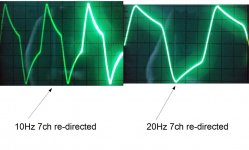 10Hz and 20Hz.jpg82.1 KB · Views: 215
10Hz and 20Hz.jpg82.1 KB · Views: 215 -
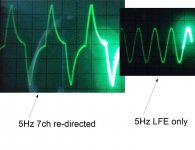 5Hz Scope.jpg80.5 KB · Views: 206
5Hz Scope.jpg80.5 KB · Views: 206
Now you see how the OPPO has failed the worst case scenario test. I'll show you a pass. I tested a Sony AVR -the STR-DE597. It is a cheap 6.1 only compatible AVR with only 1 choice of crossover settings (77Hz) with a pretty poor low end rolloff. It's master volume goes from 1-74 and with the worst case test disc I found that it's last usable master volume level with sub trim at 0dB was 56 before it went into clipping. It's clipping as opposed to the OPPO was due to it's analog preamp level's limitations.
I also show here some data from it's volume at 66 (about 9/10 of the total usable MVL). I found it very interesting that there was almost no difference at all in the shape of the waveform in reproducing a sine wave vs. a square wave due to the amount of distortion it produced at that level.
So basically, the Sony is now guaranteed to put out clean audio with any hot re-directed bass movie content you can throw at it as long as you keep the MVL under 57, everyone with me?
I then pulled out an old $200, 1st or 2nd generation bluray player with multichannel outs to see what it would do.
This is an overlay of the Panasonic showing no clipping with the worst case test and then fading into the OPPO's chopped waveform which doesn't go away no matter what volume level or trim it is set to.
The Panasonic doesn't have a master volume on it so I adjusted it's trim to -12dB to avoid full output with the worst case scenario test. I would bet that it would clip at 0dB trim but I don't know at what point it starts to distort the sine wave because I have not yet tested it's limit.
At this point I felt sick to my stomach to think that I was stuck with a supposed flagship model that was as expensive as it was with a major defect in the design and these 2 cheap POS' were actually outperforming it.
I also show here some data from it's volume at 66 (about 9/10 of the total usable MVL). I found it very interesting that there was almost no difference at all in the shape of the waveform in reproducing a sine wave vs. a square wave due to the amount of distortion it produced at that level.
So basically, the Sony is now guaranteed to put out clean audio with any hot re-directed bass movie content you can throw at it as long as you keep the MVL under 57, everyone with me?
I then pulled out an old $200, 1st or 2nd generation bluray player with multichannel outs to see what it would do.
An externally hosted image should be here but it was not working when we last tested it.
This is an overlay of the Panasonic showing no clipping with the worst case test and then fading into the OPPO's chopped waveform which doesn't go away no matter what volume level or trim it is set to.
An externally hosted image should be here but it was not working when we last tested it.
The Panasonic doesn't have a master volume on it so I adjusted it's trim to -12dB to avoid full output with the worst case scenario test. I would bet that it would clip at 0dB trim but I don't know at what point it starts to distort the sine wave because I have not yet tested it's limit.
At this point I felt sick to my stomach to think that I was stuck with a supposed flagship model that was as expensive as it was with a major defect in the design and these 2 cheap POS' were actually outperforming it.
Attachments
At this point I started to think about a test I did where I viewed the waveform of a movie scene by taking the OPPO's sub out, putting it into an interface and recording it in a DAW (digital audio workstation). The scene was HTTYD the Dragon Crash near the end of the movie. I began to remember that the peaks in the waveform looked very similar to the waveform from the sine wave test. I then looked closer at them and my heart sank. The OPPO was actually clipping source material.
Attachments
This is the 105's sub out A/B'd with the cheapo Panasonic player playing the same Dragon Crash movie scene with the levels matched. Look at how much of the dynamics the OPPO clips out of existence. This is OPPO's flagship model vs. a 200 dollar obsolete player!
I emailed OPPO back and forth and back and forth and they bounced around the issue and in the end blamed the source material for not being authored to spec. I asked them if there was a way to firmware update the unit to attenuate the 7-low pass, re-directed channels and stop this clipping from occurring and this was their response:
"Unfortunately based on what you are requesting and the likely lowered audio performance if we change it so that the channel trims occur before the DAC, it is just not likely that we will make a firmware available to correct clipping due to the source being hotter than the Dolby and DTS specifications are designed for."
-Lowered audio performance?! What's lower in performance than putting out a clipped signal with source material, will it catch of fire?
I feel like I just got mugged for my wallet.
 I can't afford to send a clipped signal to my subwoofer chain, I just can't.
I can't afford to send a clipped signal to my subwoofer chain, I just can't.
Save the headache guys, there are better players and better customer service too. They didn't even look into the tests I did. They told be the source material was to be blamed but didn't investigate it at all. For crying out loud these are major motion pictures. HTTYD had a budget of $165,000,000 and an accomplished sound team including the likes of Randy Thom!
An externally hosted image should be here but it was not working when we last tested it.
I emailed OPPO back and forth and back and forth and they bounced around the issue and in the end blamed the source material for not being authored to spec. I asked them if there was a way to firmware update the unit to attenuate the 7-low pass, re-directed channels and stop this clipping from occurring and this was their response:
"Unfortunately based on what you are requesting and the likely lowered audio performance if we change it so that the channel trims occur before the DAC, it is just not likely that we will make a firmware available to correct clipping due to the source being hotter than the Dolby and DTS specifications are designed for."
-Lowered audio performance?! What's lower in performance than putting out a clipped signal with source material, will it catch of fire?
I feel like I just got mugged for my wallet.

Save the headache guys, there are better players and better customer service too. They didn't even look into the tests I did. They told be the source material was to be blamed but didn't investigate it at all. For crying out loud these are major motion pictures. HTTYD had a budget of $165,000,000 and an accomplished sound team including the likes of Randy Thom!
Expensive 'audiophile' device easily bettered by normal commercial audio item - who would have thought it?
My guess is truncation in a digital filter. People (including people developing digital audio electronics) don't always realise that a proper reconstruction filter must be able to output signals exceeding what they might imagine to be full-scale.
My guess is truncation in a digital filter. People (including people developing digital audio electronics) don't always realise that a proper reconstruction filter must be able to output signals exceeding what they might imagine to be full-scale.
I tested the Oppo BDP-103D myself and it failed in the same way as the 105. The stronger the re-directed bass a soundtrack has, the more the OPPO's sub out clips the signal regardless of where the sub trim or master volume is set to.
Here is the waveform of a recent movie "Earth to Echo". This scene is the ship at the end of the movie. You can see how a cheap $200 1st gen Panasonic bluray player puts out a dynamic signal while the OPPO BDP-103D squashes it with clipping.
Also I found that the 103 puts around a 150-200ms delay on it's HDMI inputs. This becomes unbearable when you use a computer as the source. The noise floor on the 103's sub output was around -83.7dB, which isn't very good for people who have high powered sub rigs. It seems to cycle through menu options faster than the 105.
Also, I believe the 95, 93, and 83 have the same problem. http://www.audioholics.com/audio-technologies/0dbfs-blu-ray
The link is for Audioholics testing the Oppo BDP-83SE and finding clipping with strong source levels as well. Apparently OPPO has known about this for quite some time and refuse to correct the problem.
Here is the waveform of a recent movie "Earth to Echo". This scene is the ship at the end of the movie. You can see how a cheap $200 1st gen Panasonic bluray player puts out a dynamic signal while the OPPO BDP-103D squashes it with clipping.
Also I found that the 103 puts around a 150-200ms delay on it's HDMI inputs. This becomes unbearable when you use a computer as the source. The noise floor on the 103's sub output was around -83.7dB, which isn't very good for people who have high powered sub rigs. It seems to cycle through menu options faster than the 105.
Also, I believe the 95, 93, and 83 have the same problem. http://www.audioholics.com/audio-technologies/0dbfs-blu-ray
The link is for Audioholics testing the Oppo BDP-83SE and finding clipping with strong source levels as well. Apparently OPPO has known about this for quite some time and refuse to correct the problem.
An externally hosted image should be here but it was not working when we last tested it.
Attachments
Last edited:
This is what Oppo said about your observations:
This is only true if the disc has a LFE signal which is greater than -10dB. Almost all Blu-rays are properly mastered with an attenuation of 10dB. In the event that the disc does not have this attenuation, there will be some clipping, but in most cases clipping will not be heard since the frequency level is so low and the amount of energy going to the LFE channel is lower than the main speakers.
So, it seems that its an issue of an improperly mastered disk that would cause the clipping...
David
This is only true if the disc has a LFE signal which is greater than -10dB. Almost all Blu-rays are properly mastered with an attenuation of 10dB. In the event that the disc does not have this attenuation, there will be some clipping, but in most cases clipping will not be heard since the frequency level is so low and the amount of energy going to the LFE channel is lower than the main speakers.
So, it seems that its an issue of an improperly mastered disk that would cause the clipping...
David
Yeah well I think Dreamworks, Paramount Pictures and Disney know how to put a good sound team together. There are some giant names in sound associated with the mixes that are clipping out of the OPPOs, one of which is Randy Thom. I'm pretty sure they know how to properly produce a 7.1 bluray disc.
I've heard enough of OPPO's lame excuses. Before that one there were several others that were dancing around the issue.
The point is that the loudness wars in film are just beginning and OPPO's flagship player can't reproduce these mixes accurately while there are plenty of other manufacturer's products that can and are. Why would these other manufacturers' designs not have the same problem if it was the disc's fault?
I've heard enough of OPPO's lame excuses. Before that one there were several others that were dancing around the issue.
The point is that the loudness wars in film are just beginning and OPPO's flagship player can't reproduce these mixes accurately while there are plenty of other manufacturer's products that can and are. Why would these other manufacturers' designs not have the same problem if it was the disc's fault?
I get your point but if the standard dictates that LFE is to be recorded at -10dB maximum relative to other channels, then these recording studios are violating that standard which isn't unheard-of. looking at your latest waveform above, I really don't think that's clipping as you've called it. Its a distortion of some sort for sure but it might not be due to clipping. What was the recorded level of this test signal?
looking at your latest waveform above, I really don't think that's clipping as you've called it.
This is what Oppo said about your observations:
In the event that the disc does not have this attenuation, there will be some clipping
Look at the previous page. In this real world content, there is a LOT of clipping, not "some". The waveform is totally squashed and deprived of dynamics. Audiophile quality it isn't.
Both OPPO and Audioholics agree that it is clipping. This clipping happens regardless of where the trim and master volume levels are set to.
With loudness wars raging in music and now crossing over into film, it is silly not to provide ample headroom for a worst case scenario in the design of a product. It is obvious now at this point that other manufacturers do.
So why blame and trash the reputation of Oppo for a violation executed by the movie studios who've failed to obey their own laws and standards? Just because they are big name studios, doesn't mean they will abide by the laws they've wrote and agreed to abide by. They are run and operated by regular fallible human beings driven by the insatiable desire to make money at ALL costs .... even if it means violating their very own rules or standards. And now you want Oppo to fix this as though it is a design issue on their end???
One option is that these non-clipping players engage bass management, adjust trims and volume channels before audio decoding to avoid this clipping causing a reduction in SQ which Oppo says it will not do.
Another option is that they further reduce the sub output by -5dB(to 'cure' the problem), so that a -15dB signal is sent to the Pre-Pro/AVR for processing, instead of the standard -10dB. The AVR will add the default +10dB to this signal and hence the LFE is played at -5dB with respect to the other channels. Some AVRs have an LFE trim and could allow the user to fine-tune this to 0dB or something close.
Either way, I think its not fair to blame Oppo for disks whose sub woofer channels are encoded in a non-standard way.
One option is that these non-clipping players engage bass management, adjust trims and volume channels before audio decoding to avoid this clipping causing a reduction in SQ which Oppo says it will not do.
Another option is that they further reduce the sub output by -5dB(to 'cure' the problem), so that a -15dB signal is sent to the Pre-Pro/AVR for processing, instead of the standard -10dB. The AVR will add the default +10dB to this signal and hence the LFE is played at -5dB with respect to the other channels. Some AVRs have an LFE trim and could allow the user to fine-tune this to 0dB or something close.
Either way, I think its not fair to blame Oppo for disks whose sub woofer channels are encoded in a non-standard way.
Jury is still out on what the standards are for LFE levels. I sure as hell ain't gonna take OPPO's word on what movie soundtrack standards actually are. It is obvious with all the examples of clipped waveforms that I've found so far from different production houses that the standards are far from what they claim they are. It doesn't make any sense to leave headroom in digital media anyway because it decreases dynamic range.
I think it is totally fair to blame OPPO. Even the cheapest line of AVR's that I've tested with this real world content has not showed this problem with clipping the re-directed bass. Why would they be allowing headroom in the summed channels if it was not necessary?
I get it, you're an OPPO fanboy which is fine with me. The data I've provided here is not for you. It is for the consumer who would ask the same question as me: Why would you spend $1300 on a new player that is advertised as "natural, dynamic and engaging audiophile sound quality" if it sends out a clipped signal for content on large budget, major motion pictures when the other options in AVRs and pre/pros in this price range put out dynamic signal?
I think it is totally fair to blame OPPO. Even the cheapest line of AVR's that I've tested with this real world content has not showed this problem with clipping the re-directed bass. Why would they be allowing headroom in the summed channels if it was not necessary?
I get it, you're an OPPO fanboy which is fine with me. The data I've provided here is not for you. It is for the consumer who would ask the same question as me: Why would you spend $1300 on a new player that is advertised as "natural, dynamic and engaging audiophile sound quality" if it sends out a clipped signal for content on large budget, major motion pictures when the other options in AVRs and pre/pros in this price range put out dynamic signal?
Actually the data you collected I found excellent and useful, an eye opener and rather surprising that there disks out there that are mastered incorrectly in an attempt to make their LFE channels louder and more dynamic. The LFE standards were set by Dolby in conjunction with the movie studios years ago and Oppo is simply following them to the letter, as written.
I'm curious ...does this distortion happen on the Oppo HDMI outputs as well? Can you test the Sub output of your AVR?
I'm curious ...does this distortion happen on the Oppo HDMI outputs as well? Can you test the Sub output of your AVR?
The LFE standards were set by Dolby in conjunction with the movie studios years ago and Oppo is simply following them to the letter, as written.
Welcome to the now. Most of the best soundtracks these days are in DTS-MA. Dolby's standards have become not so standard it would seem and other manufacturers seem to be hip with the times as their products allow headroom for a worst case mix of LFE plus plenty of re-directed bass for an unclipped sub out.
Times change along with trends in mixing in film and music. For your product to remain relevant you have to adapt and it seems that OPPO is sticking their head in the sand on this one and not supporting their product. These mixes with strong LFE and re-directed bass are not going away, they are here to stay. I'm trying to warn as many people as I can that it isn't worth the money for even the $600 OPPO 103 if what you get is bad support and a clipped signal.
Like I stated though in the OP though, the problem with the OPPO seems to be with the re-directed bass, not necessarily with the levels of the LFE. It can handle a full tilt LFE track by itself no problem. It is the re-directed bass with the LFE track that is causing the clipping. In the source material, I wouldn't assume that the level on the LFE is at 0dBFS. I have a good feeling that OPPO is just using that as a cop out. They did not show me one shred of evidence or data to back up or explain their claim. They didn't even try to duplicate the results with the source material on their end. Does that seem like good customer service to you?
Point well taken...I guess the solution would be to use a bit-streamed or decoded PCM output from the HDMI port to the AVR and not to use the LFE output for movies but music and other such sources.
I'm surprised they were not willing to try resolve this issue. I will do my part and maybe they relent and change their mind. They are usually good at that, maybe now that the product is very mature and they'd rather not mess with anymore FW updates?
I'm surprised they were not willing to try resolve this issue. I will do my part and maybe they relent and change their mind. They are usually good at that, maybe now that the product is very mature and they'd rather not mess with anymore FW updates?
I haven't tested the HDMI to AVR route simply because I wasn't interested in the results of the test. $1300 is a bit much to only send the digital downstream to an AVR and not take advantage of the Sabre DACs.
Thanks but OPPO had their chance to make this right for me and they only gave me a headache. This thing is going to end up on Ebay soon and I'll have a new player and pre/pro soon. The main thing I learned from this is not to trust anyone's marketing department. Apparently these days it's up to the consumer to test the products to see if they perform as advertised which is just sad.
Thanks but OPPO had their chance to make this right for me and they only gave me a headache. This thing is going to end up on Ebay soon and I'll have a new player and pre/pro soon. The main thing I learned from this is not to trust anyone's marketing department. Apparently these days it's up to the consumer to test the products to see if they perform as advertised which is just sad.
Oppo's response below:
Like we have said several times, if we find that any fix will degrade the audio for all sources, we will not pursue a fix. The engineers here and the engineers at MediaTek are aware of the observations of this customer, and we are in dialogue with them about possible solutions, but at this time we do not have any resolutions to any observed LFE clipping due to a source which was mastered incorrectly to the DTS and Dolby Digital specifications.
Like we have said several times, if we find that any fix will degrade the audio for all sources, we will not pursue a fix. The engineers here and the engineers at MediaTek are aware of the observations of this customer, and we are in dialogue with them about possible solutions, but at this time we do not have any resolutions to any observed LFE clipping due to a source which was mastered incorrectly to the DTS and Dolby Digital specifications.
Jeez. Once again, it's not LFE clipping, it's a problem with multiple channels of re-directed bass combining with the LFE channel and it happens in the digital domain since the trim levels will not correct this.
I appreciate your efforts dmusoke but they are going to continue talking in circles about this until you go away. They are not in dialogue with me, they flat out refused to address the problem with their products. -Notice they aren't even concerned with what the media sources were (YES, there are quite a few now that I've found that clip their player's sub out). They don't duplicate the results on their end to verify that I'm correct let alone contact these production houses to ask what standards they are going by in authoring their bluray discs. Like I said man... done with OPPO, time to move on to a truly high end product. I just want everyone out there who is considering using their players to take into account this design flaw and the kind of support you can expect from them if some other defect pops up.
I appreciate your efforts dmusoke but they are going to continue talking in circles about this until you go away. They are not in dialogue with me, they flat out refused to address the problem with their products. -Notice they aren't even concerned with what the media sources were (YES, there are quite a few now that I've found that clip their player's sub out). They don't duplicate the results on their end to verify that I'm correct let alone contact these production houses to ask what standards they are going by in authoring their bluray discs. Like I said man... done with OPPO, time to move on to a truly high end product. I just want everyone out there who is considering using their players to take into account this design flaw and the kind of support you can expect from them if some other defect pops up.
- Home
- Source & Line
- Digital Source
- OPPO BDP-105 Sends CLIPPED signal on sub out for movies with strong re-directed bass!
